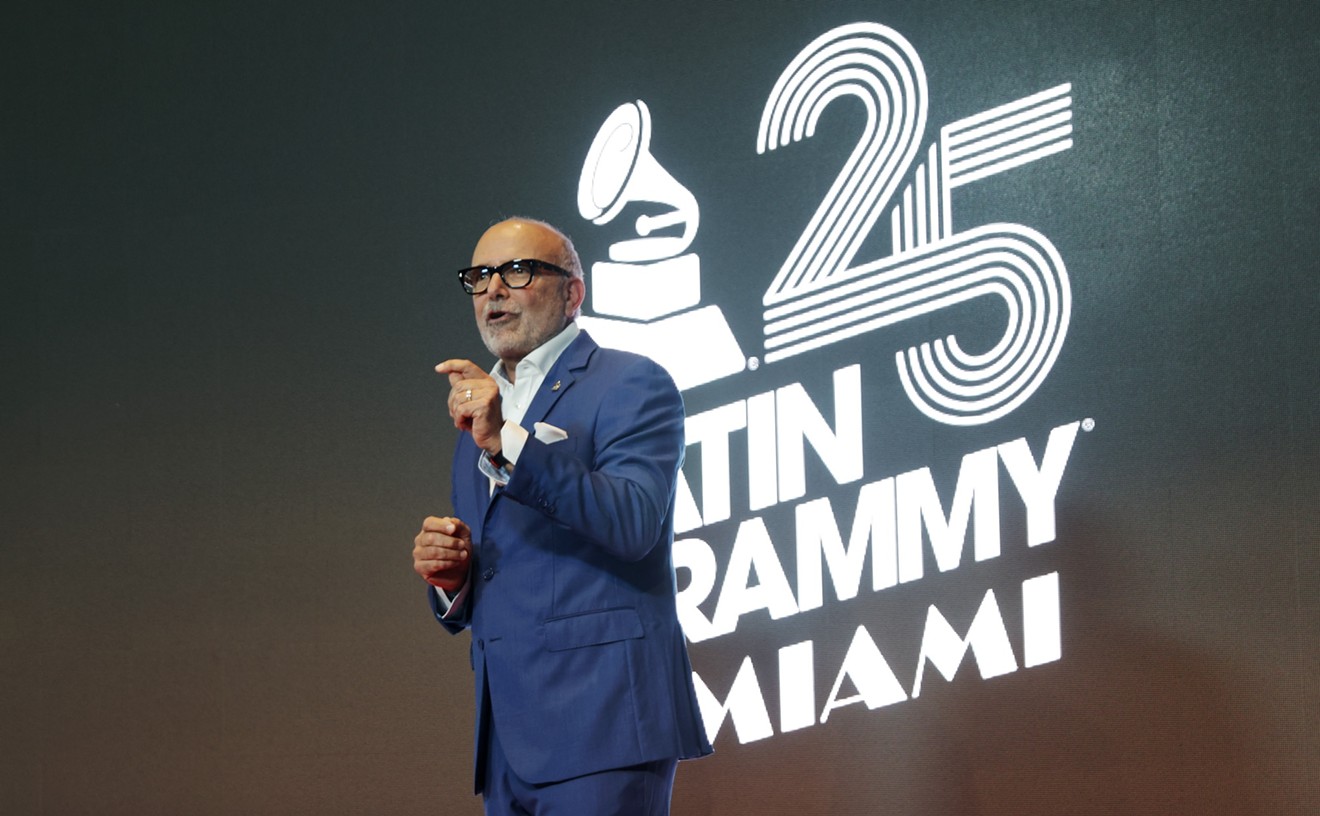In the spring of 2013, during a time Miami Beach city leaders proposed to bulldoze the Fillmore to make way for chic condos, Lauren "Lolo" Reskin, the owner of Sweat Records, blogged about what the suggested demolition meant to her.
“To hear that we might lose the Fillmore," she wrote, “is the worst possible news for music lovers in South Florida... Losing the Fillmore would be a huge step backwards, with booking agents again seeing Miami as a desert for their artists.”
Reskin wasn't alone in her opinion. Thousands of Miamians were outraged that the venue — a favorite of many locals — was planned to be destroyed. Music lovers felt like they were about to be tossed out on the street. Due in large part to the public outcry, though, the Fillmore was spared.
However, plans to tear it down have, once again, been revitalized. Instead of replacing it with condos, though, local politicians this time envision building a massive hotel on the Fillmore’s current site.
After a yearlong deliberation, the seven-member Blue Ribbon Committee — formed by Mayor Philip Levine to assess whether the city should build the hotel — reached a consensus June 1 that Miami Beach would greatly benefit from a convention center hotel on the Fillmore site.
Indeed, a convention “headquarters” hotel would make visits to Miami Beach easier for conventioneers, allowing them more convenient access to their rooms. However, city leaders could not have chosen a more beloved building to demolish to make way for the new lodgings.
“It’s insulting as a resident of Miami that they would take something that residents love so much to put up another hotel for tourists," Reskin tells New Times. "We’re all enriched by the Fillmore being in our community. The performances it hosts make Miami more livable for everyone who loves music. To not have that in our scene is literally going to decrease quality of life for South Floridians.”
The Fillmore is not only beloved but also one of South Florida’s most visited midsize music venues, and — as the concert hall’s Facebook fans have said — it has stood sentry on that corner of Washington Avenue and 17th Street for the better part of 70 years, representing Miami Beach’s live music and performing arts scene.
“We’re committed to bringing great live music and events to South Florida and hold a deep appreciation for the storied history, dating back to the 1950s, at The Jackie Gleason Theatre and now the Fillmore," said a Fillmore Miami Beach spokesperson in a statement. "Our goal is to continue to bring more great acts to Miami Beach without interruption for many years to come."
Though it is certainly part of South Beach history, attracting everyone from Frank Sinatra to Lana Del Rey over the years, the Fillmore (formerly known as the Jackie Gleason Theater) isn’t officially deemed a historic landmark though because it’s been remodeled numerous times. Despite this technicality, Miami's foremost architectural historians believe the Fillmore's site should be respected.
"Although the building is not designated as historic — it has been altered significantly over the years — the site itself has historic significance as a center for concerts and theater over the last several decades in Miami Beach," Daniel Ciraldo, the executive director of the Miami Design Preservation League, tells New Times. "We hope that whatever is planned will preserve the significance of the site and allow for improved and ongoing performances at this important location."
Although the Fillmore isn't a registered historic site, its quirky '80s take on art deco has helped ingratiate it to many locals. A story published in New Times last week said the Fillmore is so iconic it's kind of easy to ignore, not because its style isn't alluring — the building is quite charming — but because it just seems so settled. It's as fixed in South Beach as the Freedom Tower is entrenched in downtown Miami.
Despite the structure's recognizability, last week Commissioner Ricky Arriola told New Times there are plans, after the Fillmore is razed, to construct a "revitalized" music venue in another area of the city-owned convention center complex. Arriola said the new building would have at least as many seats as the old venue and with better acoustics. But some locals fear that tearing down the Fillmore would put local music lovers in limbo for years, particularly because the current plans for the hotel are more substantial than a new performing arts venue.
In response to last week's New Times' story about the demolition, local culturist Leslie Feldman wrote on Facebook that it was "pure delusion" to believe another music venue would be readily constructed for locals.
"If you think for one moment that the Fillmore (Jackie Gleason Theatre) can be 'torn down and rebuilt, in another location' as Ricky Arriola says... to make way for a convention center hotel, think again and then slap yourself in the face to wake up. There will be no rebuild. None. Not now, not ever. The... Adri[e]nne Arsht PAC was built more than 10 years ago and it cost right around $485 MILLION... was two years late in going on-line, over budget and severely scaled down from original plans. Where is the City of Miami Beach going to get a new $600 million dollars to build a new Performing Arts Center, in 2020 money? Get real. Get serious. It will never happen. It will never be a priority, and will never have the money. Tear it down and it's gone forever..."
Reskin also tells New Times she is skeptical of city leaders making good on their promise of constructing a better Fillmore, at least anytime soon. "I, unfortunately, do not trust the Miami Beach government to oversee and execute the rebuilding of a brand-new music venue," she says. "They clearly have more concern for hotel developers than for the citizens of South Florida, and everyone should be pretty damn angry about that."
Now that the Blue Ribbon Committee has recommended to commissioners and Mayor Levine that a hotel be built on the Fillmore site, among the bullet points in the plan is coaxing residents to go along with the scheme. However, drumming up public support might be more difficult than anticipated. As of last Friday, there has been a swell of people who have declared they not only stand rigidly opposed to the Fillmore's bulldozing but also will band together to oust any city official who supports its destruction.
Perhaps city leaders have opened up a can of worms — or a gateway to Hell — with this plan to replace the Fillmore with a hotel. Though a convention center hotel might be beneficial, there's a resounding reaction from locals that depriving people of the long-standing cultural center is an affront to locals' way of life.
Meanwhile, a social media page that Reskin set up in 2013 to save the Fillmore has now been stirred by the recent drama. "The fact they want to take away one of the region's main cultural offerings is insane. It’s so shortsighted," she says.
Fancy hotels are great, but people don't visit cities simply to stare at their hotel rooms. People like to venture out and see a city's cultural offerings. If the Fillmore were destroyed, not only locals but also visitors would lose out. They could always shop at the chain stores on Lincoln Road, though.
[
{
"name": "Air - MediumRectangle - Inline Content - Mobile Display Size",
"component": "19274298",
"insertPoint": "2",
"requiredCountToDisplay": "2"
},{
"name": "Editor Picks",
"component": "17482312",
"insertPoint": "4",
"requiredCountToDisplay": "1"
},{
"name": "Inline Links",
"component": "18711090",
"insertPoint": "8th",
"startingPoint": 8,
"requiredCountToDisplay": "7",
"maxInsertions": 25
},{
"name": "Air - MediumRectangle - Combo - Inline Content",
"component": "17482310",
"insertPoint": "8th",
"startingPoint": 8,
"requiredCountToDisplay": "7",
"maxInsertions": 25
},{
"name": "Inline Links",
"component": "18711090",
"insertPoint": "8th",
"startingPoint": 12,
"requiredCountToDisplay": "11",
"maxInsertions": 25
},{
"name": "Air - Leaderboard Tower - Combo - Inline Content",
"component": "17482313",
"insertPoint": "8th",
"startingPoint": 12,
"requiredCountToDisplay": "11",
"maxInsertions": 25
}
]













